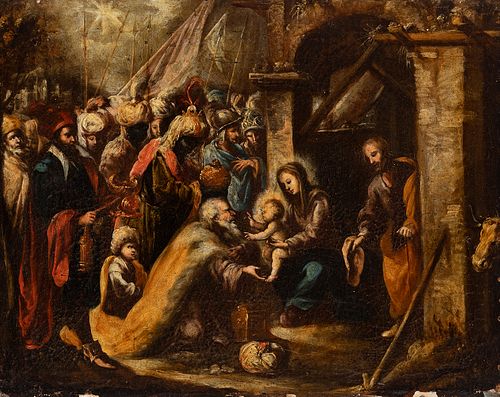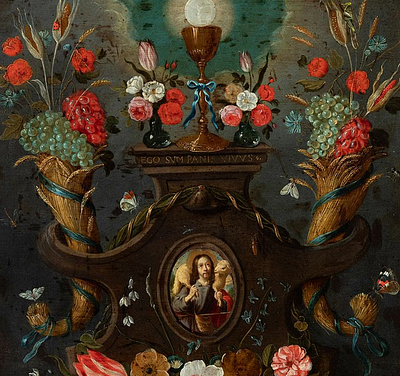Cordovan school; late 17th century. "The Adoration of the Magi". Oil on canvas. Re-retouched.
Lot 31
About Seller
Setdart Auction House
Carrer Aragó 346
Barcelona
Spain
Setdart Subastas was born in 2004 and is currently the first online art auction in Spain with solidity, prestige and reliability guaranteed by our more than 60,000 users. Setdart has a young, dynamic and enterprising team ready to successfully manage the purchase and sale of art works through custom...Read more
Estimate:
EUR€1,500 - EUR€2,000
$1,578.95 - $2,105.26
Absentee vs Live bid
Two ways to bid:
- Leave a max absentee bid and the platform will bid on your behalf up to your maximum bid during the live auction.
- Bid live during the auction and your bids will be submitted real-time to the auctioneer.
Bid Increments
| Price | Bid Increment |
|---|---|
| EUR€0 | EUR€10 |
| EUR€200 | EUR€25 |
| EUR€500 | EUR€50 |
| EUR€1,000 | EUR€100 |
| EUR€3,000 | EUR€200 |
| EUR€5,000 | EUR€500 |
| EUR€10,000 | EUR€1,000 |
| EUR€20,000 | EUR€2,000 |
| EUR€50,000 | EUR€5,000 |
About Auction
By Setdart Auction House
Sep 21, 2021
Set Reminder
2021-09-21 10:00:00
2021-09-21 10:00:00
America/New_York
Bidsquare
Bidsquare : 21st September - ARAS JÁUREGUI Private Collection - Old Masters, 19th & 20th Century
https://www.bidsquare.com/auctions/setdart-auction-house/21st-september---aras-j-uregui-private-collection---old-masters-19th-20th-century-7429
Setdart Auction House sofia@setdart.com
Setdart Auction House sofia@setdart.com
- Lot Description
Cordovan school; late 17th century. "The Adoration of the Magi". Oil on canvas. Re-retouched. It presents erased inscriptions on the back and repainting. Measurements: 34 x 45,5 cm. This work represents the moment in which the three kings, accompanied by their great retinue, present their gifts to the child Jesus. This one, in his mother's arms, seems to play with one of the kings, probably Gaspar, kneeling before him. The scene is set outside, with a reference to the nativity scene on the right, transformed into classical architecture, defined by a semicircular arch and columns flanking the exterior. The richly coloured and richly decorated robes of the kings, such as the ornaments on the headdress worn by Balthasar, show the luxury of this procession. The scene takes place almost in semi-darkness, as can be seen in the opening to the landscape in the last shot. However, the luminosity is clear and the focus is on the figure of the child Jesus, who radiates the light that falls on the rest of the figures. The grandeur of the work can be seen in the multitude of figures, and in the choice of a composition full of movement and dynamism, where each of the figures is studied individually and as a whole, showing different postures and planes. This mastery in the profusion of figures and the mastery of a complex composition are heirs to the painting that developed in Cordoba during the Baroque period. The 17th century saw the arrival of the Baroque in the Andalusian school, with the triumph of naturalism over Mannerist idealism, a loose style and many other aesthetic liberties. At this time the school reached its greatest splendour, both in terms of the quality of its works and the primordial status of Sevillian Baroque painting. Thus, during the transition to the Baroque period, we find Juan del Castillo, Antonio Mohedano and Francisco Herrera el Viejo, whose works already display the rapid brushstrokes and crude realism of the style, and Juan de Roelas, who introduced Venetian colourism. The middle of the century saw the fullness of the period, with figures such as Zurbarán, a young Alonso Cano and Velázquez. Finally, in the last third of the century we find Murillo and Valdés Leal, founders in 1660 of an Academy where many of the painters active during the first quarter of the 18th century were trained, such as Meneses Osorio, Sebastián Gómez, Lucas Valdés and others.
- Shipping Info
-
In-house shipping available. Please inquire at admin@setdart.com.
-
- Buyer's Premium



 EUR
EUR CAD
CAD AUD
AUD GBP
GBP MXN
MXN HKD
HKD CNY
CNY MYR
MYR SEK
SEK SGD
SGD CHF
CHF THB
THB














